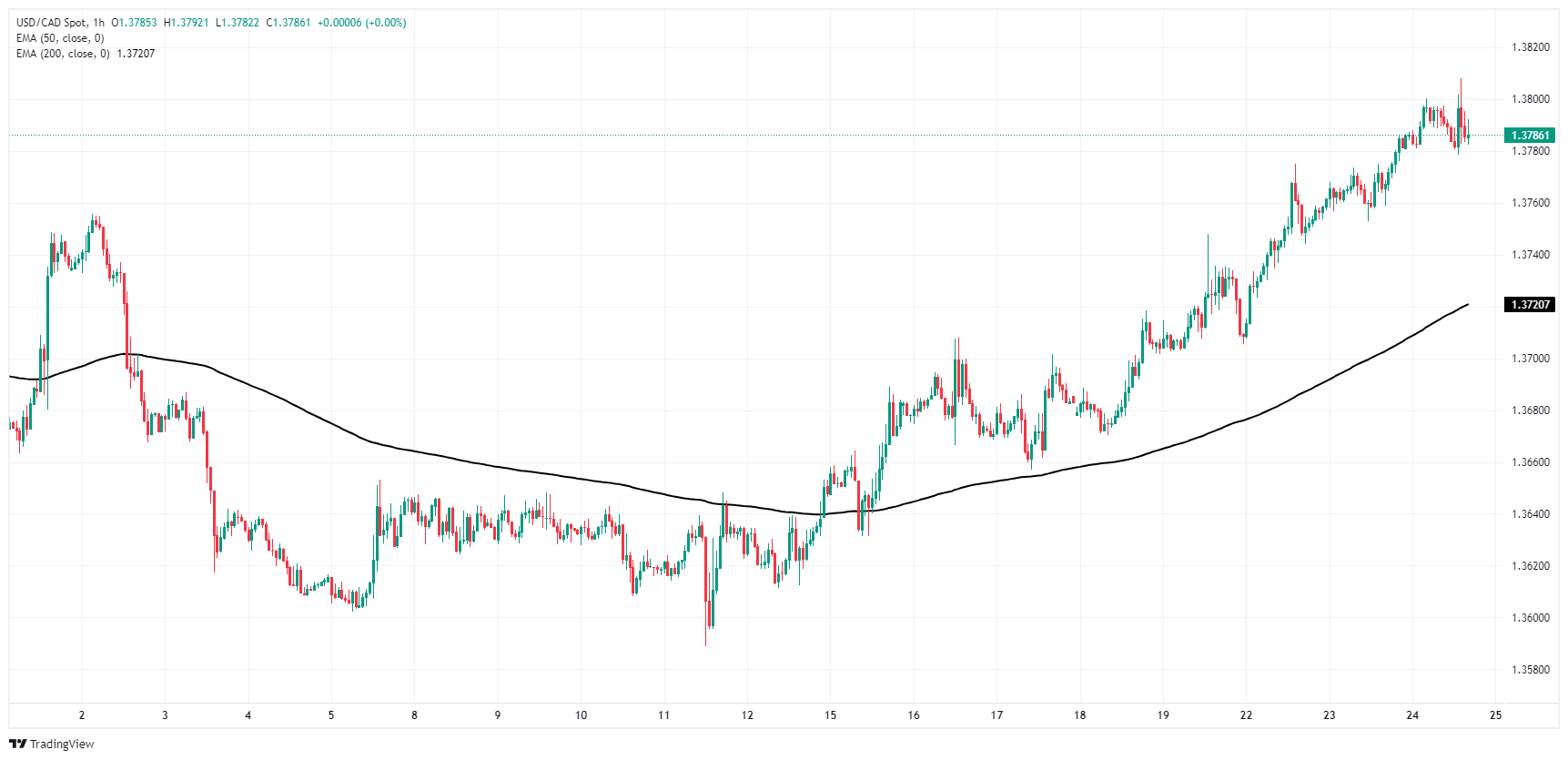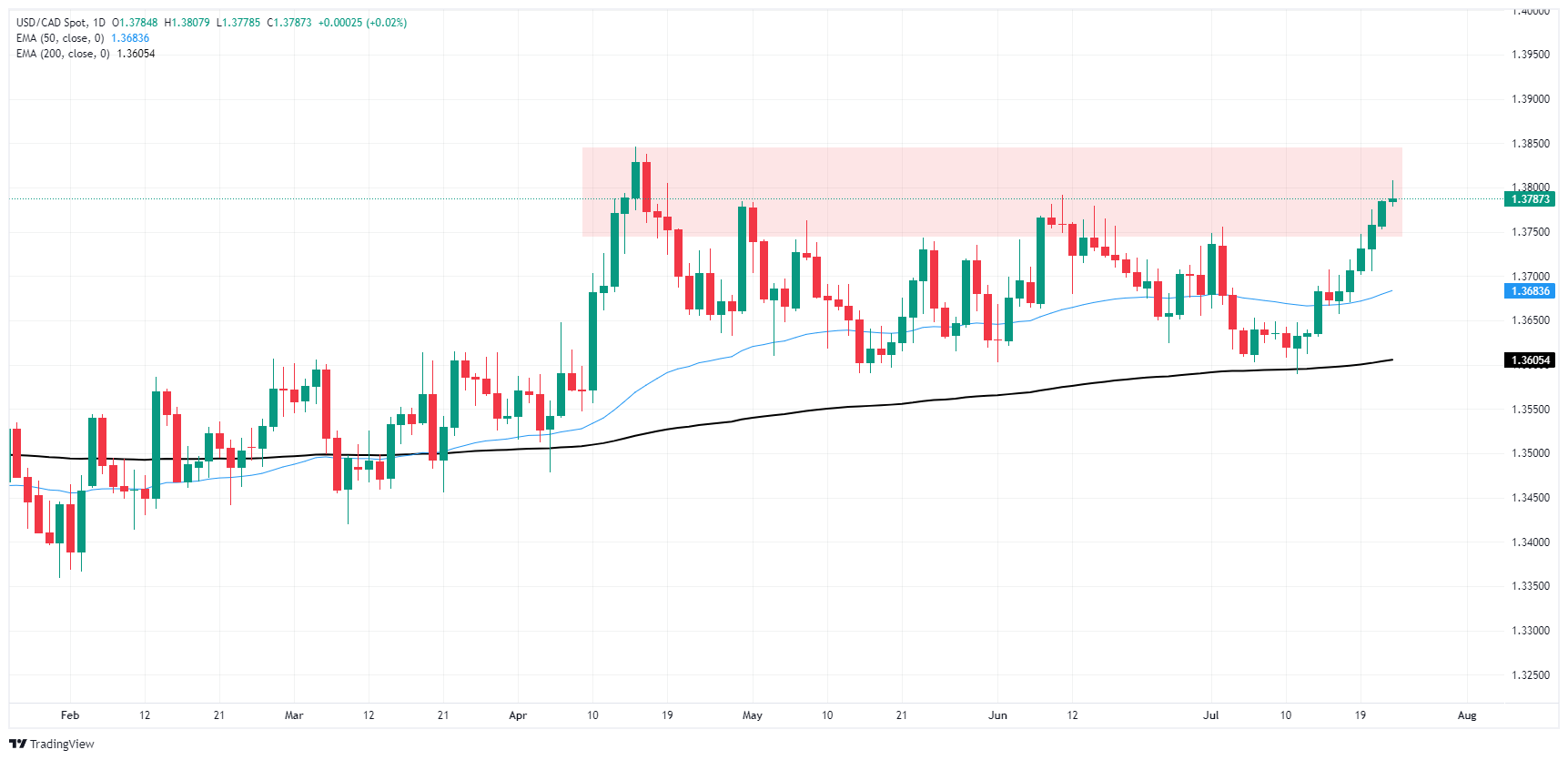Canadian Dollar roils after BoC delivers a rate cut but revises growth forecast lower
- The Canadian Dollar struggles to hold flat against the Greenback after initial slide.
- Canada is headed for an uncertain growth patch as forecasts get revised lower.
- Mixed US PMIs also complicate the picture as the rest of the week looms large.
The Canadian Dollar (CAD) briefly slipped to a 14-week low against the Greenback after the Bank of Canada (BoC) cut rates by another 25 basis points, as markets broadly expected. Further downside revisions to the BoC’s Canadian growth forecasts hobbled the Canadian Dollar, and the USD/CAD pair is posed for a second straight week of gains.
Canada has delivered another rate cut, in-line with the BoC’s own promises of “a series of cuts” in the second half of 2024, but CAD traders are having a difficult time shrugging off steep downside adjustments to Canadian Gross Domestic Product (GDP) growth forecasts as well as a sharp Q1 revision. On the US side of things, US Purchasing Managers Index (PMI) figures came in mixed, with Manufacturing activity contracting and Services unexpectedly expanding to its highest level since April of 2022. Key US data will continue through the week, with US GDP on the docket for Thursday and US Personal Consumption Expenditure Price Index (PCE) inflation slated for Friday.
Daily digest market movers: BoC delivers expected cut, but revises growth forecasts lower
- As markets broadly expected, the BoC cut benchmark rates by a quarter-point to 4.5%.
- What surprised CAD traders was a steep downside revision in the BoC’s growth forecasts, which now expects 2024 GDP to grow by 1.2% for the year compared to April’s forecast 1.5%, an already-low figure.
- The BoC also sees 2024’s first-quarter growth at just 1.7% on an annualized basis, far lower than the previous forecast of 2.8%.
- BoC's Governor Macklem: Monetary policy is still restrictive
- US PMIs came in fiercely mixed, with Manufacturing PMI figures sinking into contraction territory while Services PMI activity surged to a 26-month high.
- Read more: US S&P Global Manufacturing PMI slumps to 49.5
Canadian Dollar PRICE Today
The table below shows the percentage change of Canadian Dollar (CAD) against listed major currencies today. Canadian Dollar was the strongest against the Australian Dollar.
| USD | EUR | GBP | JPY | CAD | AUD | NZD | CHF | |
|---|---|---|---|---|---|---|---|---|
| USD | 0.03% | -0.13% | -1.34% | 0.00% | 0.25% | 0.21% | -0.80% | |
| EUR | -0.03% | -0.17% | -1.40% | -0.01% | 0.23% | 0.22% | -0.85% | |
| GBP | 0.13% | 0.17% | -1.23% | 0.13% | 0.39% | 0.36% | -0.69% | |
| JPY | 1.34% | 1.40% | 1.23% | 1.40% | 1.63% | 1.59% | 0.55% | |
| CAD | -0.01% | 0.01% | -0.13% | -1.40% | 0.25% | 0.23% | -0.82% | |
| AUD | -0.25% | -0.23% | -0.39% | -1.63% | -0.25% | -0.03% | -1.04% | |
| NZD | -0.21% | -0.22% | -0.36% | -1.59% | -0.23% | 0.03% | -1.04% | |
| CHF | 0.80% | 0.85% | 0.69% | -0.55% | 0.82% | 1.04% | 1.04% |
The heat map shows percentage changes of major currencies against each other. The base currency is picked from the left column, while the quote currency is picked from the top row. For example, if you pick the Canadian Dollar from the left column and move along the horizontal line to the US Dollar, the percentage change displayed in the box will represent CAD (base)/USD (quote).
Technical analysis: CAD wobbles but so far holds steady against Greenback
The Canadian Dollar (CAD) is a mixed bag on Wednesday, finding scant gains against the Antipodeans while falling back against the still-recovering Japanese Yen. Chart churn on economic data releases has also left the CAD swimming in circles against the Greenback. The CAD gained around one-fifth of one percent against the Australian Dollar (AUD) and the New Zealand Dollar (NZD), but shed one-and-one-half percent against the Japanese Yen (JPY).
USD/CAD briefly rose to a 14-week high on Wednesday, crossing over the 1.3800 handle before settling back into the day’s opening range. Intraday price action is still holding north of 1.3780, but momentum is leaning increasingly in favor of Greenback buyers.
Daily candlesticks are buried in the middle of a heavy supply zone priced in above 1.3750, and a bearish turnaround from here could send USD/CAD tumbling backto the 200-day Exponential Moving Average (EMA) at 1.3609.
USD/CAD hourly chart
USD/CAD daily chart
Canadian Dollar FAQs
The key factors driving the Canadian Dollar (CAD) are the level of interest rates set by the Bank of Canada (BoC), the price of Oil, Canada’s largest export, the health of its economy, inflation and the Trade Balance, which is the difference between the value of Canada’s exports versus its imports. Other factors include market sentiment – whether investors are taking on more risky assets (risk-on) or seeking safe-havens (risk-off) – with risk-on being CAD-positive. As its largest trading partner, the health of the US economy is also a key factor influencing the Canadian Dollar.
The Bank of Canada (BoC) has a significant influence on the Canadian Dollar by setting the level of interest rates that banks can lend to one another. This influences the level of interest rates for everyone. The main goal of the BoC is to maintain inflation at 1-3% by adjusting interest rates up or down. Relatively higher interest rates tend to be positive for the CAD. The Bank of Canada can also use quantitative easing and tightening to influence credit conditions, with the former CAD-negative and the latter CAD-positive.
The price of Oil is a key factor impacting the value of the Canadian Dollar. Petroleum is Canada’s biggest export, so Oil price tends to have an immediate impact on the CAD value. Generally, if Oil price rises CAD also goes up, as aggregate demand for the currency increases. The opposite is the case if the price of Oil falls. Higher Oil prices also tend to result in a greater likelihood of a positive Trade Balance, which is also supportive of the CAD.
While inflation had always traditionally been thought of as a negative factor for a currency since it lowers the value of money, the opposite has actually been the case in modern times with the relaxation of cross-border capital controls. Higher inflation tends to lead central banks to put up interest rates which attracts more capital inflows from global investors seeking a lucrative place to keep their money. This increases demand for the local currency, which in Canada’s case is the Canadian Dollar.
Macroeconomic data releases gauge the health of the economy and can have an impact on the Canadian Dollar. Indicators such as GDP, Manufacturing and Services PMIs, employment, and consumer sentiment surveys can all influence the direction of the CAD. A strong economy is good for the Canadian Dollar. Not only does it attract more foreign investment but it may encourage the Bank of Canada to put up interest rates, leading to a stronger currency. If economic data is weak, however, the CAD is likely to fall.